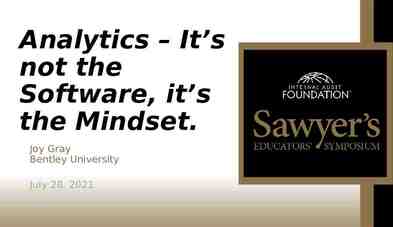Chapter 9 Checking Accounts and Banking Services 9.1 Checking
22 Slides378.06 KB
Chapter 9 Checking Accounts and Banking Services 9.1 Checking Accounts 9.2 Banking Services and Fees
5 Elements of PF Income Spending Savings Investme nts Protection Salary Rent Cash in Bank Bonds Life Insurance Bonus Mortgage Payments Emergenc y Savings Stocks Car Insurance Overtime Taxes Savings Account Mutual Funds Health Insurance Hourly Wages Food Checking Account Real Estate Estate Planning Dividends Credit Card Money Markets Art
Savings and Spending
Lesson 9.1 Bank Accounts GOALS Financial Institutions: Credit Unions Vs Banks Describe the purpose of a checking account Discuss the types of Bank Accounts Budget
Bank Versus Credit Union Both offer: checking & savings accounts, CDs, loans and business accounts, and financial services Commercial Bank – for profit Pros Cons More Locations Higher Fees for account services Better technology Lower Interest rates – CDs and savings Reward Programs Higher fees on Loans Credit Pros Unions – Non-Profit Cons Great Customer Service Require Membership Higher Interest Rates – CD and savings Less Locations Lower Fees – loans & account services Less Technology
Why Should We Use a Bank
Why we Should use a Bank From the Video: What are three reasons we should have a bank account? 1. Security – banks offer security for you to store your Both are federally Insured Not carrying cash – reduces loss due to theft 2. Structure – all your financial information is in one place Teaches you how to budget Less likely to overspend 3. Save money – not charged by others to cash you checks
Pick a Federally Insured Banking Option Most banks are covered. Always check for this when opening an account, either at a Bank or a Credit Union Both are Federally Insured Banks by FDIC Credit Unions by NCUA Coverage for FDIC and NCUA are for: Insured up to 250,000 per person Checking and savings accounts For Money Market Accounts For CDs Insurance does not cover: stocks, bonds, U.S. Treasury securities (T-bills) safe deposit boxes, annuities, and insurance products
Choosing Not to Bank Complete Ed Puzzle
Google Classroom Assignments: Complete the Looking for Change video and answer the questions in ED Puzzle. Upon completion, Open the Article from our class web page and complete the top of page 2 in your note packet.
From Video 30 Million People a year use check cashing services Because want money right away 3-5 days for a check to clear the bank 89 billion a year paid in fees Fees the amount we spend on groceries Prepaid cards: Fees to cash the check, fees to turn into a Prepaid card, fees for every transaction
Check Cashing Options: If you have no bank – options include: Any Local Bank: fees from 8 - 25.00 per check Check Cashing Kiosks – in retail location 1%-5% of check Walmart: 4 for checks 1,000 8 for checks 1,000 - 5,000. Personal checks of up to 200 for a fee of 6 Check Cashing Store: typically charge a fee & a percentage Ex: to cash a 2,000 check, a 5 fee plus 1% adds up to a 25 deduction from your paycheck Side Note: When using a Debit Card and asks if you want cash back – can be really expensive. Definitely more expensive than an ATM
When you use a Bank
Types of Bank Accounts: Checking Savings Money Market Certificate of Deposit Specialty Savings Accounts
Types of Bank Accounts: Checking account - An account you open at a bank to deposit your money and to make payments (withdraw) from Savings Account – want to save money for the short or long-term goals and not concerned about getting the best interest rate (relatively low interest) Money Market – for people who want to save money for short or long-term goals and want to earn slightly higher interest than a savings account (minimum monthly balance requirements and 6 transactions per month). Certificate of Deposit - are time savings accounts: meaning you agree to leave your money in the account for a set period. During that time, your money earns interest and, when the CD matures, you can withdraw your savings or roll it into a new CD Specialty Savings Accounts: - People who want accounts tailored to specific savings goals but Just keep in mind that there may be restrictions on when and how you can withdraw those funds later. Example: HAS accounts, IRA accounts, Student Savings Account
Check Account Interest Rates Which is higher Total Free, or Premium CD Interest Rates Which is higher Checking or CDs
Checking Account Main Account: Open a Checking Account as Your main Account Depositor: is the person who owns the account This should be your main account at a bank – should have savings also Do not keep all your money in this account, just what you budget to spend for the day or week You receive a debit card to use for your transactions – set up to work only from this account Click for Video
Checking Account Main Account: Purpose of Checking Account: Deposit your net income To make payments for bills and daily expenses (primary purpose of a checking account) Withdrawal using a debit card, ATM machine, write a check, or for automatic payments for bills Track what you have spent and where you have spent it Some may use it to earn interest, but not likely Should be used to decide how you will spend, save or invest your money
Money For Spending and Savings Net Income: Total wage after taxes are withheld. This money is used to pay for necessities, to save, or to spend on wants Disposable income is the amount of money you have left over after you've paid all your federal, state and local taxes. AKA Used to pay bills first Discretionary income is the money you have left over after you've paid your taxes and paid all your necessary living expenses – spend on what you want Checking account, SHOULD BE USED TO CONTROL SPENDING & SAVINGS.
CONTROL SPENDING & SAVINGS Do not keep all your money in the Checking account, just what you budget to spend for the day or week, or 2 weeks Checking Main Account Savings Account Emergency Short Term Christmas Christmas Long Term Money Market/CD Allowance Cassie Allowance Ken
CONTROL SPENDING & SAVINGS If you earn 1000 net wage every 2 weeks. you should save 20%, 50% for bills, and 30% on spending however you want. You should split your rent, utilities, and food: What is your disposable income? Checking Leave 500 Savings Account Emergency Move 200 Christmas Move 50 - Start with 50% on bills/necessities - Next 20% in savings - Finally, spending: what you will do with the rest? Move 150 Allowance Move 50 Money Market Allowance 50
CONTROL SPENDING & SAVINGS If you earn 1750 net wage, how would you allocate this? Enter this into your note packet - Start with what you must leave for bills/necessities - Next what you will save - Finally, what you will do with the rest



























